Competitive
Rope Climbing in the Czech Republic
by Jiří
Tlamsa
October 2005
. .
.
Olympic History – the first gold medal
for the Czech
Republic
The history
of Czech competitive rope climbing began in the Olympic Games in Paris in1924.
Bedřich
Šupčík won the first Olympic gold
medal in this sport for the Czech Republic.
His winning time without using his legs on an 8 meter
rope was 7.2
seconds. In the same event, another Czech gymnast, Ladislav
Vácha, received the bronze
medal for a time of 7.8 seconds. After these Olympic Games the 8 meter
competitive event was abandoned in the Czech Republic, and climbing ropes were retained only in
school gymnasiums.
The Resurrection of Competitive Rope climbing
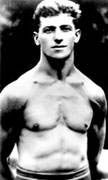 The
turning point in the history
of Czech competitive
rope climbing occurred in early 90´s, when Radko
Valík from Sokol Příbram had the
idea of organizing a competition in the rope climb, in honor of Bedřich
Šupčík,
the first Czech Olympic winner. In Příbram, in 1993, the
first modern event in rope climbing made its debut, named the B.
Šupčík´s Memorial. Rules
of
the climb in this competition were the same as in Paris
in 1924. The climber began in a seated position
on the floor, with one hand grasping the rope and the other hand in the
air
approximately at the level of shoulders. After an acoustic starting
signal the
competitor could climb without the use of legs, employing the hands
only. The length of the rope was 8 meters, as in Paris .
The Memorial was a great success and has been held every year since.
The
turning point in the history
of Czech competitive
rope climbing occurred in early 90´s, when Radko
Valík from Sokol Příbram had the
idea of organizing a competition in the rope climb, in honor of Bedřich
Šupčík,
the first Czech Olympic winner. In Příbram, in 1993, the
first modern event in rope climbing made its debut, named the B.
Šupčík´s Memorial. Rules
of
the climb in this competition were the same as in Paris
in 1924. The climber began in a seated position
on the floor, with one hand grasping the rope and the other hand in the
air
approximately at the level of shoulders. After an acoustic starting
signal the
competitor could climb without the use of legs, employing the hands
only. The length of the rope was 8 meters, as in Paris .
The Memorial was a great success and has been held every year since.
Bedřich
Šupčík
In
a short time rope climbing became popular across the country, and
competitions were established in various cities. At the start of the
new century climbers could compete in more than ten events on the 8 meter
rope. The first official Championship in rope climbing in the Czech
Republic occurred in 2001.
All competitions during the year act as qualifiers for the National
Championship, which includes the 20 – 30 best climbers of the
season.
A year before the 2004 Olympiad
in Athens the first repeat of the 1896 Olympic event was held, using a
46 meter rope. Since then, each year there is a special
competition on this extremely long rope, which has become quite a show
for spectators and a very exciting event for competitors.
Development of Rope Climbing Rules
Initially, there was an
effort to climb according the 1924 Paris rules. As mentioned before,
the length of the
rope was 8
meters,
and climbers started in a seated position with one hand on the rope and
another at the
level of shoulders. During the climb, after the starting signal, the
legs could be moved - in a kicking motion - but could not
grasp the rope. The climber's time was recorded when he touched the
final mark at 8 meters.
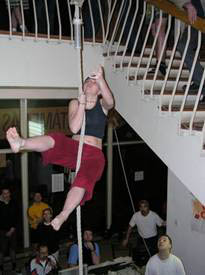 However,
it became obvious these rules were inadequate. Some climbers used their
legs at the beginning of the climb (they
pushed themselves off from the floor with their legs), or started
climbing before
the acoustic signal (they grasped the rope with both hand before the
signal),
and the hand-held stopwatch was a poor timing mechanism. Referees were
overly tolerant. It became necessary to ensure the uniformity of all
competitions.
However,
it became obvious these rules were inadequate. Some climbers used their
legs at the beginning of the climb (they
pushed themselves off from the floor with their legs), or started
climbing before
the acoustic signal (they grasped the rope with both hand before the
signal),
and the hand-held stopwatch was a poor timing mechanism. Referees were
overly tolerant. It became necessary to ensure the uniformity of all
competitions.
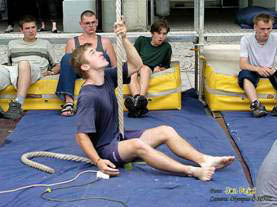 Over
time the present set of rules have evolved. Today climbers start also
in the seated
position; one hand grasps the rope anywhere the climber wishes, but the
second hand must be on the starting button of the electronic timer (see
picture on right).
The second hand may release the button only after the acoustic signal.
If the
button is released before the signal, the time is not recorded and
the climber must
repeat the climb. At 8 meters there is an
electronic sensor, which reacts to the touch
of the hand (see picture on left). This sensor is connected with the
starting button.
So the recorded time is regulated, with the precision of hundreds of a
second. Also, it is crucial that the climber lift the legs from the
floor
before the seat, or at the same moment. With this rule all climbers
start
without bouncing and the timing is correct. The implementation of these
rules led to
a degradation of times on the 8 meter event.
So it is not possible to compare the best times across decades.
Over
time the present set of rules have evolved. Today climbers start also
in the seated
position; one hand grasps the rope anywhere the climber wishes, but the
second hand must be on the starting button of the electronic timer (see
picture on right).
The second hand may release the button only after the acoustic signal.
If the
button is released before the signal, the time is not recorded and
the climber must
repeat the climb. At 8 meters there is an
electronic sensor, which reacts to the touch
of the hand (see picture on left). This sensor is connected with the
starting button.
So the recorded time is regulated, with the precision of hundreds of a
second. Also, it is crucial that the climber lift the legs from the
floor
before the seat, or at the same moment. With this rule all climbers
start
without bouncing and the timing is correct. The implementation of these
rules led to
a degradation of times on the 8 meter event.
So it is not possible to compare the best times across decades.
Junior men and women climb a
shorter rope – 4.5 meters. Its
diameter is about 3 centimeters (1.2 inches).
In each competition climbers are allowed
3 or 4 attempts. Climbers compete on an individual rope or on two ropes
simultaneously.
Best climbers and Records on the 8 meter Rope
In 1993 the first modern record was established for the 8 meter climb: trooper L. Cimburek won the event in 9.09
seconds.
Considering the times from the Olympiad in Paris
on the same length of rope, it was clear that this time would be
very
quickly overcome. On the other hand no one was certain if the gold medal time of 7.2 seconds, set by
Šupčík in Paris, would be challenged.
Climbers from Sokol Bratislava
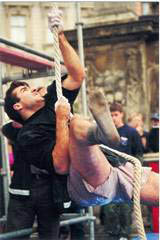 Climbers from Sokol Bratislava led the way from the very first modern competition. Martin
Masár - a very dynamic climber - excelled. From the very beginning in 1994 , he won every match and
gradually
improved his own record. In 1997 Martin set the Czech record for 8 meters
with the astounding
time of 5.58 seconds. In the following years he confirmed his skill with very
good
times under 6 seconds. However, in 2000 Martin lost an event and decided to terminate his
carrier.
Climbers from Sokol Bratislava led the way from the very first modern competition. Martin
Masár - a very dynamic climber - excelled. From the very beginning in 1994 , he won every match and
gradually
improved his own record. In 1997 Martin set the Czech record for 8 meters
with the astounding
time of 5.58 seconds. In the following years he confirmed his skill with very
good
times under 6 seconds. However, in 2000 Martin lost an event and decided to terminate his
carrier.
Martin Masár was the
first czech climber to break Šupčík´s time of 7.2
seconds, which is still regarded as a “magic
time to beat”.
Besides Masár, sport club Sokol Bratislava has had several other
good climbers,
especially Martin Vašek and Tomáš
Trník. They both beat
Šupčík´s time.
Vašek has his own personal record of 7.02 seconds. Trník's best time is 6.70
seconds.
Epoch
of
Josef
Křivánek
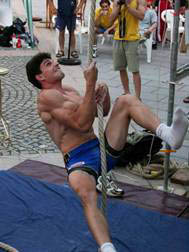 In
1997 another
legendary rope climber, Josef Křivánek, from Troubsko, started his successful carrier. In his
first event he was
the sixth with a time over 9 seconds, but after one year of training he
became the
second man in Czech rope climbing on the 8 meter rope (before this date he climbed
as a junior on the 4.5 m
rope).
In the years 1998 - 2000 he was usually second after Masár,
losing by only tenths of second. In 2000 Masár won his last
match at 5.91 seconds
(Křivánek was the
second with a time of 6.27),
and after this time he retired from climbing. So from this date the “epoch
of Josef
Křivánek” began - lasting more than 4 years.
Křivánek won all 42
competitions in which he climbed in this period. His performances peaked in 2003,
when he
set his own record on the 8 m rope – 5.84 seconds. Křivánek is also the holder
of the best time on the14 meter rope - at 15.44 seconds. In march 2005 Křivánek won his last
event with a time
of 6.51, and after 10 years of competitive climbing, retired from competitive climbing.
In
1997 another
legendary rope climber, Josef Křivánek, from Troubsko, started his successful carrier. In his
first event he was
the sixth with a time over 9 seconds, but after one year of training he
became the
second man in Czech rope climbing on the 8 meter rope (before this date he climbed
as a junior on the 4.5 m
rope).
In the years 1998 - 2000 he was usually second after Masár,
losing by only tenths of second. In 2000 Masár won his last
match at 5.91 seconds
(Křivánek was the
second with a time of 6.27),
and after this time he retired from climbing. So from this date the “epoch
of Josef
Křivánek” began - lasting more than 4 years.
Křivánek won all 42
competitions in which he climbed in this period. His performances peaked in 2003,
when he
set his own record on the 8 m rope – 5.84 seconds. Křivánek is also the holder
of the best time on the14 meter rope - at 15.44 seconds. In march 2005 Křivánek won his last
event with a time
of 6.51, and after 10 years of competitive climbing, retired from competitive climbing.
Who was faster
– Masár or Křivánek ?
Martin
Masár is the holder of the best time on the 8 meter rope – 5.58 s. However, the significance of
his record is reduced because the rules at the time of his climb allowed
a bounce
with the legs from the floor and also a premature start (these are
evident
from the video of his record climb). In 2003 Josef Křivánek
climbed the rope in
a time of 5.84, when the newer, stricter rules applied. Climbers
frequently discuss the question: who was faster, Křivánek or
Masár? Videos of both record climbs show the speeds of both climbs
were - to the eye -
approximately the same.
Young Climbers Appear on the Scene
Besides Křivánek and Masár, there are other good
climbers who have broken the 7 second
barrier. One of the greatest of Křivánek´s
rivals was Michal Nedomlel, a good rock climber, who broke the 7 second
barrier
in 2003 with a time of 6.86 seconds. The last couple of years Michal has taken a competitive
break, but
his time will soon come.
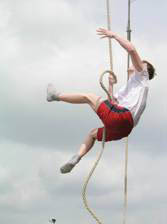
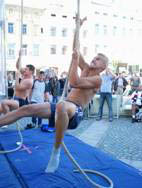 So far this year, five young climbers set personal records under 7 seconds. One from this group
will surely be
the new Czech Champion for the year. Th best of these is Martin
Matěj,
who was timed at 6.55 seconds (picture on left). Only 3 hundreths
of
second slower was Štěpán Muchka with a time 6.58.
Probably the biggest favorite
for the year’s Championship is Libor Hroza, who is also the best
speed climber in the Czech Republic, as well as in international contests.
On the 8 meter rope Libor has so far recorded
6.70.
So far this year, five young climbers set personal records under 7 seconds. One from this group
will surely be
the new Czech Champion for the year. Th best of these is Martin
Matěj,
who was timed at 6.55 seconds (picture on left). Only 3 hundreths
of
second slower was Štěpán Muchka with a time 6.58.
Probably the biggest favorite
for the year’s Championship is Libor Hroza, who is also the best
speed climber in the Czech Republic, as well as in international contests.
On the 8 meter rope Libor has so far recorded
6.70.
Two leading Czech gymnasts, Aleš
Novák (picture on right)
and Aleš Kočí, both from Sokol
Šternberk, have equal times of 6.91 seconds. It is very
likely that all these climbers will improve their records very soon,
probably
in the next competition.
Rope
climbs this Year
This
year there were 7 competitions as qualifiers for the ultimate contest
of the season, the Championship of the Czech republic, which will
include the best 20 climbers. Current winning times are about 6.5
seconds. But it is likely that during the
Championship there will be a better time, perhaps under 6 seconds. In
the near
future climbers will surely perform the 8 meter climb in under 6
seconds.
To see the Records of all Czech Competitions, click here
 The
turning point in the history
of Czech competitive
rope climbing occurred in early 90´s, when Radko
Valík from Sokol Příbram had the
idea of organizing a competition in the rope climb, in honor of Bedřich
Šupčík,
the first Czech Olympic winner. In Příbram, in 1993, the
first modern event in rope climbing made its debut, named the B.
Šupčík´s Memorial. Rules
of
the climb in this competition were the same as in
The
turning point in the history
of Czech competitive
rope climbing occurred in early 90´s, when Radko
Valík from Sokol Příbram had the
idea of organizing a competition in the rope climb, in honor of Bedřich
Šupčík,
the first Czech Olympic winner. In Příbram, in 1993, the
first modern event in rope climbing made its debut, named the B.
Šupčík´s Memorial. Rules
of
the climb in this competition were the same as in  However,
it became obvious these rules were inadequate. Some climbers used their
legs at the beginning of the climb (they
pushed themselves off from the floor with their legs), or started
climbing before
the acoustic signal (they grasped the rope with both hand before the
signal),
and the hand-held stopwatch was a poor timing mechanism. Referees were
overly tolerant. It became necessary to ensure the uniformity of all
competitions.
However,
it became obvious these rules were inadequate. Some climbers used their
legs at the beginning of the climb (they
pushed themselves off from the floor with their legs), or started
climbing before
the acoustic signal (they grasped the rope with both hand before the
signal),
and the hand-held stopwatch was a poor timing mechanism. Referees were
overly tolerant. It became necessary to ensure the uniformity of all
competitions.  Over
time the present set of rules have evolved. Today climbers start also
in the seated
position; one hand grasps the rope anywhere the climber wishes, but the
second hand must be on the starting button of the electronic timer (see
picture on right).
The second hand may release the button only after the acoustic signal.
If the
button is released before the signal, the time is not recorded and
the climber must
repeat the climb. At
Over
time the present set of rules have evolved. Today climbers start also
in the seated
position; one hand grasps the rope anywhere the climber wishes, but the
second hand must be on the starting button of the electronic timer (see
picture on right).
The second hand may release the button only after the acoustic signal.
If the
button is released before the signal, the time is not recorded and
the climber must
repeat the climb. At  Climbers from Sokol Bratislava led the way from the very first modern competition.
Climbers from Sokol Bratislava led the way from the very first modern competition.  In
1997 another
legendary rope climber, Josef Křivánek, from Troubsko,
In
1997 another
legendary rope climber, Josef Křivánek, from Troubsko, 
 S
S